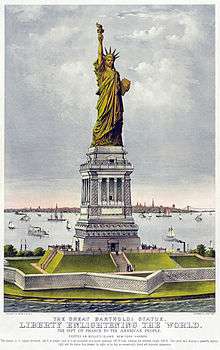Americana

Americana are artifacts, or a collection of artifacts, related to the history, geography, folklore and cultural heritage of the United States.[1][2] Many kinds of material fall within the definition of Americana: paintings, prints and drawings; license plates or entire vehicles, household objects, tools and weapons; flags, plaques and statues, and so on. Patriotism and nostalgia play defining roles in the subject. The things involved need not be old, but need to have the appropriate associations. The Atlantic described the term as "slang for the comforting, middle-class ephemera at your average antique store—things like needle-pointed pillows, Civil War daguerreotypes, and engraved silverware sets."[3] The term may be used to describe the theme of a museum or collection,[4][5] or of goods for sale.[6]
The term can also be used to describe studies of American culture, especially studies based in other countries.[7] Americana music is contemporary music that incorporates elements of various American roots music styles, including country, roots-rock, folk, bluegrass and blues, resulting in a distinctive roots-oriented sound.[8][9]
Americana as nostalgia
From the mid through late 20th Century, Americana was largely associated with nostalgia for an idealized life in small towns and small cities in America around the turn of the century, from roughly 1880 to the First World War, popularly considered "The Good Old Days".[10] It was believed that much of the structure of 20th Century American life and culture had been cemented in that time and place. Henry Seidel Canby wrote "[I]t is the small town, the small city, that is our heritage. We have made twentieth-century America from it, and some account of these communities as they were ... we owe our children and grandchildren."[11] The nostalgia for this period was based on a remembrance of confidence in American life in this period that was due to such factors as a sense that the Frontier had been "conquered" with the US Census Bureau's declaration that it was "closed" in 1890, as well as the recent victory in the Spanish–American War.[10] As Canby put it, Americans at this time "really believed all they heard on the Fourth of July or read in school readers. They set on one plane of time, and that the present, the Declaration of Independence, the manifest destiny of America, the new plumbing, the growth of the factory system, the morning paper, and the church sociable. It was all there at once, better than elsewhere, their own, and permanent. ... They had just the country they wanted...and they believed it would be the same, except for more bathtubs and faster trains, forever ... for the last time in living memory everyone knew exactly what it meant to be an American."[11] The zeitgeist of the idealized period is captured in the Disneyland-style theme parks' Main Street, U.S.A. section (which was inspired by both Walt Disney's hometown of Marceline, Missouri and Harper Goff's childhood home of Fort Collins, Colorado),[12] as well as the musical and movie The Music Man and Thornton Wilder's stage play Our Town.[10] Especially revered in Americana nostalgia are small town institutions like the barber shop,[13] the drug store/soda fountain and ice cream parlor,[14] the latter which would be resurrected by mid-twentieth century nostalgia for this time period in businesses like the Farrell's Ice Cream Parlour chain with its 1890s theme.[15]
Examples
- Columbia, the personification of the United States
- Coca-Cola[16][17]
- Levi's blue jeans, especially Levi's 501s[17][18]
- White picket fences[19]
See also
References
- ↑ "Americana".
- ↑ "Americana". Dictionary.com.
- ↑ Giovanni Russonello. "Why Is a Music Genre Called 'Americana' So Overwhelmingly White and Male?". The Atlantic.
- ↑ Princeton Collections of Western Americana
- ↑ University of Cincinnati German-Americana collection Archived May 31, 2009, at the Wayback Machine.
- ↑ 'Americana' styled modern hardware
- ↑ "AMERICANA".
- ↑ Shriver, Jerry (31 August 2009). "Grammys will be putting Americana on the map". USA Today.
- ↑ "2011 Grammy Category Descriptions" (PDF). Retrieved 18 December 2012.
- 1 2 3 Sears, Stephen (1975). Hometown U.S.A. New York: American Heritage. pp. 6–9. ISBN 0-671-22079-9.
- 1 2 Canby, Henry Seidel (1934). The Age of Confidence: Life in the Nineties. New York: Farrar & Rinehart. ASIN B000857UVO.
- ↑ "Local History Archive Larimer Legends - Old Town & Disneyland - City of Fort Collins, Colorado". Library.ci.fort-collins.co.us. Retrieved 2013-12-19.
- ↑ Sears, Stephen (1975). Hometown U.S.A. New York: American Heritage. pp. 12–13, 29. ISBN 0-671-22079-9.
- ↑ Sears, Stephen (1975). Hometown U.S.A. New York: American Heritage. pp. 12–13, 20. ISBN 0-671-22079-9.
- ↑ "Farrell's looks to restart growth Owner outlines expansion plans for iconic ice cream chain". Nation's Restaurant News. August 31, 2010. Retrieved 4 June 2014.
- ↑ Melvin, Don. "Coca-cola A Sip Of Americana Things Have Been Going Better With Coke Since 1886." Florida Sun-Sentinel. 7 October 1990
- 1 2 Day, Sherri and Stuart Elliot. "Coca-Cola Goes Back to Its 'Real' Past." New York Times. 10 January 2003
- ↑ Babcock, Gregory. "10 American Menswear Essentials That Will Literally Never Go Out of Style." Complex. 9 April 2015
- ↑ Xiong, Nzong (2008-03-03). "White picket fences appease homeowners". TuscaloosaNews.com. McClatchy-Tribune News Service. Archived from the original on 2015-09-02.
Americana aside, people like white picket fences for a couple of practical reasons.
External links
| Look up Americana or americana in Wiktionary, the free dictionary. |
| Wikimedia Commons has media related to Americana. |